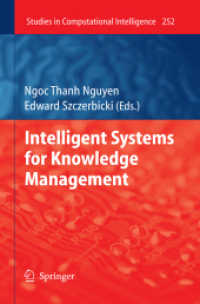- ホーム
- > 洋書
- > 英文書
- > Performing Arts
Full Description
This monograph adapts terms and concepts from linguistics, structuralism and semiotics to develop a grammar for the ten extant, complete dramas from first-century Rome and five Humanist plays from Renaissance Italy. In a language, letters combine to form words, which create sentences, paragraphs and so on. This book posits that there is a similar structure to dramatic texts, and explores the way basic elements (i.e., performers, roles, the stage, actions, mental states and effects) combine into figures and stage business, which then form scenes, acts and plays. The study uncovers patterns within the structure, as well as changes in these patterns, which reveal insights into, not what story the playwright is telling, but how he goes about telling it.
Much of this work depends upon the methods and results of The Dramaturgy of Senecan Tragedy (Ann Arbor: 2013), which sought out elements of stagecraft and poetics in the plays attributed to Lucius Annaeus Seneca. A series of appendices apply these same methods to the pseudo-Senecan Hercules Oetaeus and Octavia, as well as the plays composed in the Tre- and Quattrocento.








